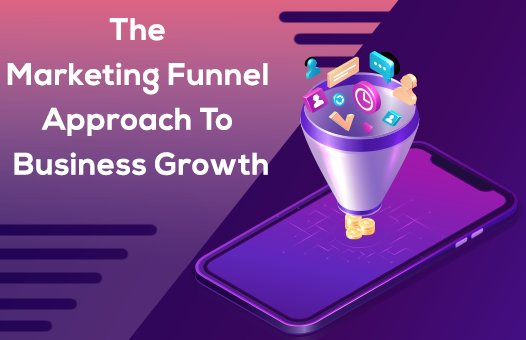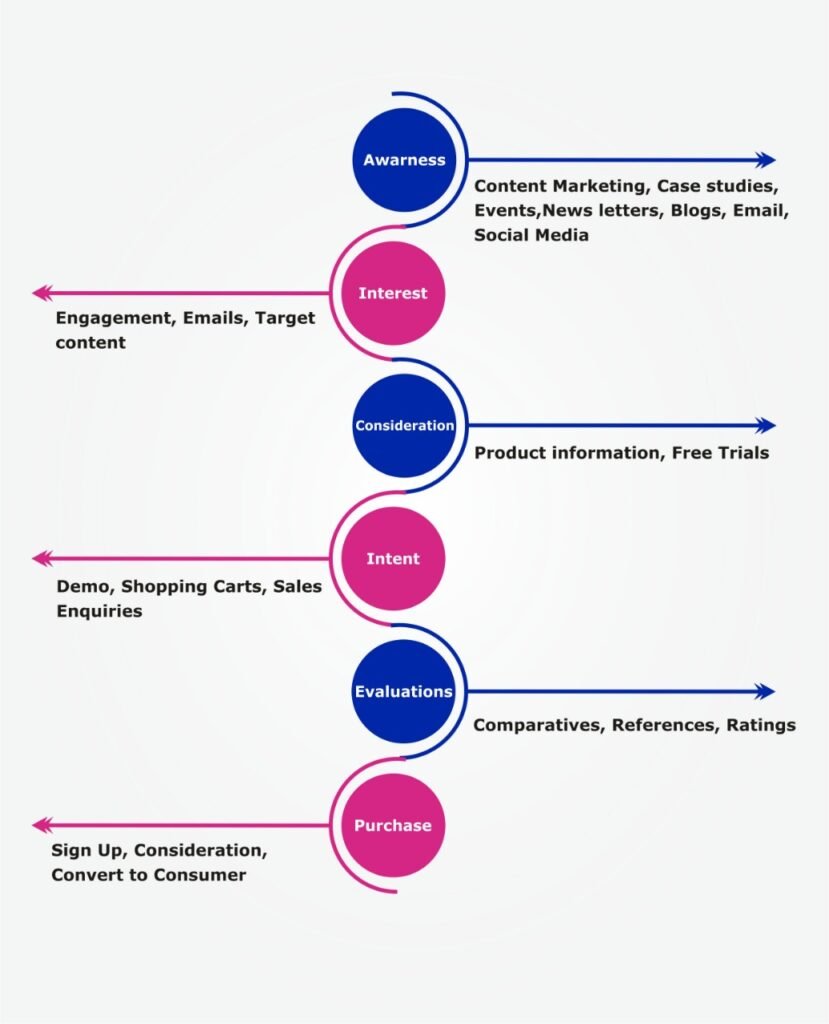
What is a marketing funnel approach and how is it used?
Marketing Funnel approach, is the science of evaluating the customer movement right from the time you unveil information about your products and services to create an “Initial awareness” to the “Eventual purchase” mode wherein the customer takes decisive steps to buy your product or service.
For some products or services, the funnel movement would extend to purchase feedback surveys and ratings to help augment retention, referencing, cross sell and up sell. This creates a continuity of the funnel leading to augmentation of the base funnel. Some examples include B2B funnels and e-commerce funnels.
Hence, it is observed that there is no ‘one size fits all’ model of the funnel. Marketing funnels differ as per the type of business viz. B2B, B2C, or B2B2C, mode of sale – online or offline, levels of intermediaries – direct or indirect. The number of stages could be few or many with different nomenclature and sequences. However, the core essence would be summed up as AIDA – Awareness, Intent, Decision making and Action taken by the customer.
Marketing funnel approach helps you to observe and analyse when the customers drop off without conversion. Also, it helps one understand what motivates them to fill the cart and pay the moolah.
A Marketing funnel approach is possibly a series of sequential steps a potential customer needs to go through before they can reach the final stage of decision making. It is a good dashboard to visualise, imagine and defines the outcomes of the entire process from start to finish.
The success matrix of each stage within the marketing funnel is an outcome of the probability ratios of a particular industry. What is interesting is the success at each stage can be predefined by you. The call to action to improve the probability of each stage is called marketing intervention and includes catalysts.
If you want your business sales process to run efficiently and with greater consistency as possible, you definitely must get your marketing funnel approach right – the process of nurturing a curiosity or a casual browser into a paying customer.
Marketing has rapidly evolved in recent years with the advent of digital marketing. The earlier mantra of “build and upload a website and the customers follow suit” no longer makes sense. You would actually be in an incognito mode in that case. The competition is omnipresent and dynamic. Also, Google’s algorithms are undergoing mutations and you need to expect the unexpected.
Hence a ‘one size fits all’ marketing solution or a “build it, upload it, forget it” kind of approach is waste of your time and resources. Marketing funnel approach strategy needs to be defined with professional support, run with “On your toes” approach and taste like “freshly baked cookies”.
The recommendation is to have a long-term marketing vision to create a digital marketing funnel blueprint. As a company and a marketer, this gives you the power to;
- Reach prospective customers at any point.
- Track your funnel progress through analytics.
- Rearrange your marketing interventions and deploy catalysts.
Moreover, the moment we start talking about traffic, people get defensive, and comes the excuse, “Our competition works with a fat budget, we’re just novice starting out and will need considerable time to attract attention”.
“Can we attract the right volume and relevant traffic without having to overspend valuable resources?”
Definitely you can seek traffic without paying much for it. You just need to pursue it with passion, which comes from consistency, right content and the right tools. Once you locate your customer, offer him the value he is searching for, cater to his needs, and the rest will follow. We all need to start somewhere, sometime, but not with anybody, rather just the right partner only.
The proof of the pudding is in getting the footfalls to your site. This can be ensured if you know “who is your customer” and what products and services are relevant to him/her. This can be facilitated by Customer Insight surveys, optimized SEO oriented content, high probability media, blogs and white papers, effective back links and more.
When the leads start moving within the funnel, the marketing interventions get more subtle as you take these leads deftly through the stages of the funnel. Here you connect with the potential customers at each stage of the funnel, understand the trends and the potential shortcomings for interim corrections along way, until those leads reach the bottom of the funnel to become customers.
If all the suspects at the “Awareness stage” were to become customers, the marketing funnel would be more like a marketing cylinder. Though marketing cylinder is not a reality for businesses, striving to widen the funnel into cylindrical is an inspirational part of the marketing job, more of an ideal situation.
Marketing funnel stages and conversions
To have a full understanding of how it works, let’s go through the funnel stage by stage.

1. Awareness
Awareness is to display the value of your product or service, provide the USP, educational information and build a relationship with your subscriber.
This is the opportunity to start developing a trust relationship with the prospects. Hence you would demonstrate the value of your product through your communication, free trials and give interesting details to build a relationship with your potential customers.
Awareness is the “on your marks” mode in the marketing funnel. It is created through a bunch of activities like customer insights, select trials, teaser campaigns, Below the Line (BTL) marketing campaigns, and customer-discovery. Here the potential customers are exposed to the knowledge, visuals, references and sometimes experiences about a product or service.
Building awareness with SEO
Events, trade shows, content (graphics, quizzes, games, blog posts etc.), viral campaigns, media mentions, search, direct mail and more help consolidate the thought leadership and trust. Here, lead development takes place based on the degree of curiosity, and as more information is collected the leads are worked upon for nurturing further down the funnel.
In digital marketing building awareness with SEO would include targeting the low intent keywords and keeping the sales talk to its minimum. You can refer to your services or products as subtle promotion catering to the need of customers.
Building awareness with social media
Social media may not be very effective in latter stages of the marketing funnel. But, it’s a basic platform for building awareness and a powerhouse of outcomes. Also, it is important to figure out the right digital marketing networks and correct channels which are most important to your audience. The content need to be engaging and would play a pivotal role to grab the attention of the audience.
2. Interest
The moment a lead is generated, the customer moves on to the interest stage, here they learn more about the company and its background, its products and services, and any relevant information and specifics it provides.
This is an opportunity for the marketer to develop a relationship with the customer in its lead management system and predict the intensity of the need. The leads need to be nurtured through engagement in form of customer reach by tele-calling, SMS, emails, newsletters, references and relevant information about the brand and its reliability quotient.
Ensure availability of newsletter and case studies
Here we need to enable and fulfill the customer’s desire of collecting information regarding the company with more accessible mediums. This also means the customer is assigning some time slot to know about your products, services and the company.
3. Consideration
When the potential customer becomes aware and develops an interest, he moves into the mindset of consideration. Once in the consideration mode, the flirtatious customer settles down to build a more informed kind of relationship. Here he/she seems to narrow down on his/her particular needs and is only interested in relevant specifics about your brand, competition, products and services. At this stage, you would know more about your customers’ needs and preferences than you did in the previous stage. This will enable you to provide him/her with the right inputs as a solution to his/her problems.
During the consideration stage, probable customers get qualified on defined parameters to emerge as prospects. More information can be provided to such prospects regarding products and offers through email and search campaigns. Further nurturing is continued by reducing conversion barriers with free trials, targeted content, case studies, and more.
To target new leads at the conversion stage you are going to create organic search campaigns. These are the users ready to convert right now. So, your SEO strategy is going to create original content for particular conversion goals such as – “Most out of our 14-day free trial” or “A perfect guide”. You can also list Features, Advantages and Benefits (FAB) of your product vs your rivals, to rank organically for people ready to do business with your competitors.
Create Google ad campaigns that includes rival’s keywords to enter the competition and to attract the competitors’ leads at the last moment. You can also include keywords like “free delivery,” “in my area,” “best price” or anything else that displays the users’ eagerness to buy.
Maximise conversion rates by optimising your forms
Once users land on the website, the focus turns to converting them into leads. The requirement of conversion is for users to complete a form of some kind so this is the place to start with your conversion optimisation efforts.
Without writing any code Leadformly a form builder tool makes it easy to design and optimize multi-step forms.
You can make your own forms from scratch by drag and drop or use any templates and edit as per your requirement. Embed the form you have created on any page of your website.
4. Intent
“Intent reveals desire, action reveals commitment”, In the intent stage the probable customers are the ones who display their desire and are ready to seek action to complete the desire.
This is possible after a product demo, confirmation in a survey or when a product is added to a shopping cart on a website. Here the marketer can grab this opportunity to portray his product to be the best buy for a customer.
Build Customers Trust
Trust is an essential factor influencing the online shopping success or failure. Trust is a supposition that the other party will not behave artfully by taking advantage of the situation.
However, trusting an online store means being sure that the offers in the store will be always fair, and exhibit to me the right product knowledge. Trust reserves the user’s privacy, and manages the information regarding credit card transactions securely.
Trust is conviction of the user that a specific online store is efficient, the transaction will be in goodwill, and that the store is honest. Trust is declared as the consumers’ willingness to hold the transaction with a particular online shop.
Trust in technology is the conviction that the available setup is adequate to hold the financial transaction securely with safeguards.
5. Evaluation
The stage entails the customer seeking information and comparison of the key attributes of the product or service.
Subsequently the information collected or received is used to decipher which brand, product or service suit the customers’ preferences and leads to shortlisting for purchase. Here the references, testimonials and ratings provided by earlier users influence the decision making.
The marketing and the sales teams work in unison to identify, reach, and nurture the finer aspects of the customers’ decision-making process. The objective is to convince the customer and make an impression that his decision is wise.
Create short product/service videos
Short videos help to inform and educate the audience on the products and services. While being humorous, entertaining or with a social message, these videos go a long way in creating a brand recall with the consumers. These tempting bits of content are delightful, informative, with a quotient of reference and ready to share all at once.
Host a webinar
List down the topics that will add value to your customers and prospects. You could gather insights from the data you already have through analytics, social reporting, and all the tracking tools.
Search for the popular blog topics, on your products /services, of the past six months. The shortlisted topic could be included in the agenda for the webinar. A domain specialist can create the relevant content for the topic of the webinar including the FAQ’s. Modern webinar tools based on the number of participants can be adopted for the delivery of the content.
6.Purchase
The eventual outcome of a successful marketing funnel management is the Purchase stage. The probable customer indulges in some serious evaluation before deciding to execute the purchase. So accordingly, he involves himself to complete the paperwork and commercial transaction.
Here enabling seamless buying process and ease of the transaction is very important, which includes system capability and popular modes of payments.
Providing a definite turnaround time with delivery map for each activity and redress modes in case of gaps is very important.
A delighted customer is more likely to provide favourable ratings, references and can lead to augmentation of the marketing funnel and the process further continues. The conversion ratios for references are supposedly far higher than any other lead generation programmes.
Why Funnels Are Beneficial
Marketing funnels help to streamline the customers’ movement and provides for a bird’s eye view of the transition. It makes it simpler for businesses to move to a time-tested methodology of measuring the intensity of the customers buying behaviour.
Marketing funnel approach helps to measure the volume and value, with an understanding of the role catalysts play at various stages of the funnel.
You can understand when you are losing or gaining a consumer with a funnel report. It also indicates which catalyst or intervention has created a surge. The funnel effectively is the crystal ball of the marketing & sales teams.
The funnel enables a methodical approach towards the customer and his requirements, and helps organisations in sales and revenue forecasting.
Let’s take the POS billing software business as an example. Here’s how a funnel may look for them:
- Website visit
- Browsing and demos
- Sign up with credentials
- Opt for trial period offer
- Trial period support
- Go for pro version
Do consumers need to use the product before paying?
Yes, a preview or a trial period could help the customer gain insights and assess the product /services. It also helps the customer to take an informed decision about buying the product.
A pre-payment instruction to bill the customer post the trial period in case of continued usage helps to streamline the purchase and creates a barrier for non-serious types.
It is possible to monitor a marketing funnel for an e-commerce store

E-commerce based businesses are digitally enabled to view the progression of their funnel. Find below an illustration of the same.
Conclusion
Utilizing a marketing funnel approach with the nuances described above would lead to a successful marketing campaign. Eventually it provides the compass to a customer’s journey and puts you in the navigating seat. This is not something which would be achieved with a one-time activity, but is a dynamic scenario which requires constant change and innovation in your marketing funnel approach.
Marketing funnel enables you to foresee the future course of your customer movement and also empowers you to effect course correction at different stages. This opportunity gives you the flexibility for achieving substantial enhancements and efficacy to ensure positive business outcomes. If you have a great product or service but growth in sales and revenue do not seem to be robust, then you definitely need a right Marketing Funnel approach.
Many of our customers are connected to us, thanks to our simple yet effective digital marketing approach, a system created to grow online presence and traffic, nurture and convert prospects into customers and make them fall in love with your brand. Do find your brand’s voyage to success with us; do not let your ship sail without a mast.
